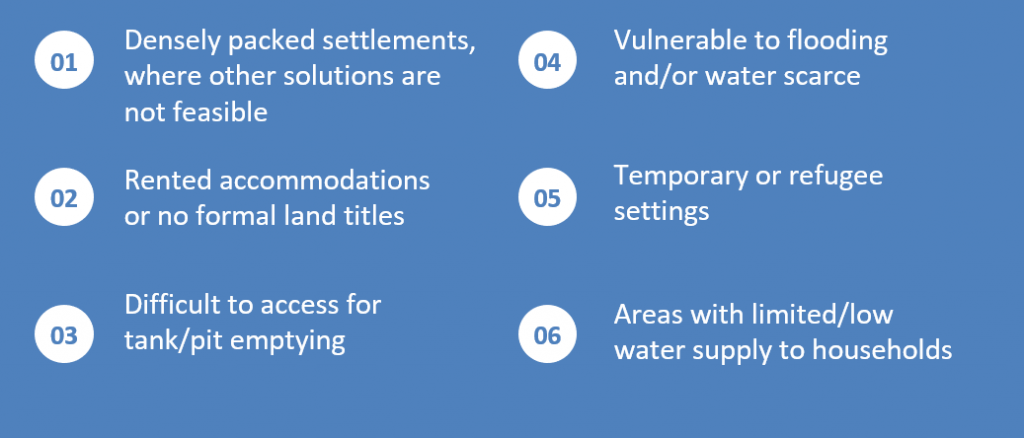Submitted by Clementine Marie Stip On Tue, 02/19/2019
co-authors: Seema Thomas, Martin Gambrill
Cities are growing at unprecedented rates, with over two-thirds of the world population projected to live in urban areas by 2050 (UN DESA 2018), and city governments struggle to keep up with the increasing demand for urban services, including sanitation. This unplanned growth and the resulting dense informal housing hinder the provision of such services. Burgeoning informal settlements are characterized by poor political representation and challenging physical and topographical conditions, such as inaccessibility, rocky soil, high water tables and periodic flooding, which make the provision of basic services especially difficult. Cities require sanitation
approaches for such settings which can complement, or precede the arrival of, traditional sewers
and conventional on-site solutions, and thus contribute to the realization of the sanitation-related
Sustainable Development Goals (SDGs). This thinking underpins the core principles of Citywide
Inclusive Sanitation (CWIS) – encouraging cities to think about a diversity of technical solutions
that provide services along the whole sanitation service chain, combining different approaches to
better respond to the challenging realities faced by cities.
Container-based sanitation (CBS) is one of the ways that such services can be provided. CBS
consists of an end-to-end service – i.e. one provided along the entire sanitation service chain –
which collects excreta hygienically from toilets designed with sealable, removable containers
and which strives to ensure that the excreta is safely treated and disposed of or reused. For cities,
this has major implications as it can help them shift their focus from exclusively building
sanitation infrastructure to that of service delivery.
Where is CBS appropriate?
Based on a review of four CBS service providers, the World Bank has identified the following
emerging lessons:
• CBS approaches should be considered as part of a menu of CWIS options, particularly
in hard-to-reach areas of cities.
• The introduction of CBS services could especially be considered for poor urban
populations for whom alternative on-site or sewer-based sanitation services might not be
appropriate.
• Adopting a conducive policy and regulatory environment could be an important first
step for governments looking to foster CBS services in areas where they could be
suitable.
• Recognizing the fact that CBS service providers will likely not be covering their full costs in the short- to medium-term, and that most urban sanitation services are
subsidized, public authorities and/or water supply and sanitation service providers could explore ways to ensure that CBS services are sustainably financed.
CBS service providers have found a way to address the whole sanitation service chain. As the service providers continue to grow and adapt their activities, we have identified some
opportunities for continued research:
• What constitutes a safe CBS service, and what are its essential features?
• How can CBS services be integrated within a broader menu of options for water supply and CWIS service provision?
• What lessons can we draw from CBS service provision and apply to the sector more
broadly?
• How do CBS approaches compare financially and economically to other available
sanitation alternatives?
• How can existing CBS service providers be supported to scale up service provision in
existing service areas or to expand into new areas?
• How could performance-based contracts be designed for CBS service provision?
To learn more about the safety, reliability, affordability and financial viability of CBS services, take a look at the main report. If you want to read specifically about the work of SOIL in Cap- Haitien, Haiti; Sanergy in Nairobi, Kenya; x-runner in Lima, Peru; or Clean Team in Kumasi, Ghana, you can consult the case studies that the report drew on.
This week, we are also presenting the report and sharing the key finding at AfricaSan5/FSM5.
Join our session at 2:30PM today in Meeting Room 2.4.1., Cape Town International Convention Center.
Source: The Water Blog, World Bank




